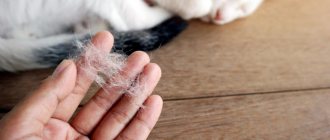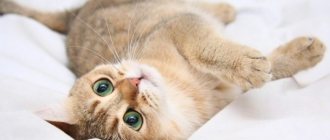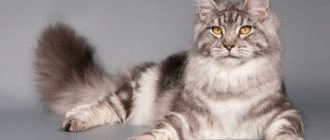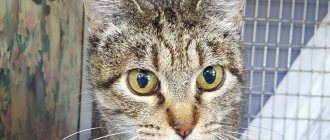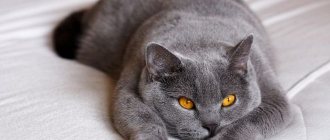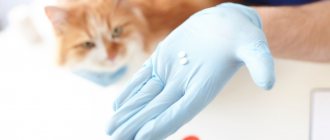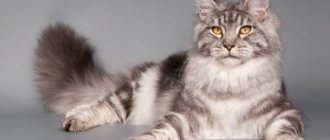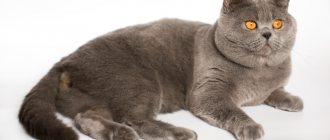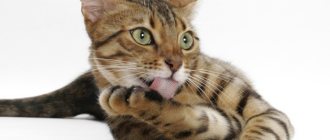The owner of a furry miracle must be prepared not only for the joys associated with the appearance of a new family member. But you should also know a lot about its development: how puberty and birth of a British cat go. How many kittens can a British cat give birth to for the first time, what should be done at a crucial moment and what should not be done - these questions must be studied before the pet arrives in the house.
It’s not difficult to bring a British cat into your home: you need to go to the nursery’s website, choose the beauty you like, and get recommendations for care. But not everyone can provide an animal with decent living conditions. You need to learn to become a pet's friend, assistant, and sometimes a doctor.
Puberty
British cats are called late breeders. Their puberty can take up to 11 months: each animal has its own developmental path. On average, plush pets mature at the age of 1 year. But in some children, initial signs appear at 4-5 months.
Estrus
The first heat of a British cat, according to the observations of British owners, begins at 7-9 months. During this period, inexperienced owners are lost and do not know what and how to help the animal. The cat screams, arches its back, raises its tail, and becomes restless. Experienced breeders know how long estrus lasts in cats of the British breed: it can last about 3 days to a week.
Recurrence of symptoms can be observed after 2 weeks if the animal is not taken for mating. The giving birth adult asks for attention from the male every three months. Don’t be afraid: the clinic’s specialists will explain how often British cats go into heat, or you can ask the owner of the cattery for advice.
It happens that the baby refuses to eat, loses weight, sheds intensely, and organizes concerts at night. Both the animal and family members suffer. Therefore, when planning to buy a British cat, you need to immediately decide: the pet is being taken for breeding or the owner does not intend to breed and, in the future, sell kittens.
Signs and symptoms
Determining heat in cats is quite simple. You need to pay attention to the following signs:
- The animal's genitals are enlarged, there is no bloody discharge, but there is a clear, generally light discharge that the cat can inherit.
- Your pet will lick itself more often, and urination may become more frequent than usual.
- Sometimes there are disturbances in appetite - the cat eats less often and less.
- Cats become more affectionate, rubbing against everything they can - furniture, owners. They also roll around on the floor and squirm. There are, of course, individuals who, on the contrary, become too aggressive during the period of heat.
- The animal tries to escape from the house, using all possible entrances and exits - windows, doors, etc.
- The animal makes plaintive, drawn-out and sometimes very loud sounds, thus calling cats.
- He bends his posture, lies down on the floor, actively tramples his hind legs and moves his tail to the side.
Mating
Only purebred animals can be bred. The cat will not give birth: it is necessary to choose a doctor to sterilize the animal. Usually the procedure is performed after the end of the acute period of estrus. The client is given sedative drops to alleviate the condition. Important: do not use hormonal drugs that cause serious disturbances in your pet’s fragile body without a veterinarian’s prescription.
14 days before the event, it is necessary to give the cat anti-worm medications and check the pets for all necessary vaccinations. It is necessary to carry out hygiene procedures: trim the claws. It is not recommended to wash it just before mating: a household product will remove the natural odor of the animal.
When to breed
After the first heat begins, they skip another one and then only find a British cat for mating. It is forbidden to bring a gentleman without waiting for the right time, the third heat. The consequences of non-compliance with the rule are sad: a miscarriage may occur, kittens will be born weak or dead.
Choosing a partner
One of the important points in choosing a partner for mating is whether the British cat has experience. The animal must be suitable in age and size. External characteristics, color and color, advantages and disadvantages of the individual, compliance with the breed standard, take into account all the data. Pay attention to the absence of diseases in the cat; strong offspring are born from healthy parents. It is better to choose a cat from your club.
A British Shorthair cat should be bred to a British Shorthair cat. It is most often not recommended to take a long-haired cat for mating. In most structures, offspring are considered marriage. To participate in exhibitions, they will find out in which system the pet is registered.
How does mating work?
The successful outcome of mating British cats depends largely on the behavior of the girl. The fluffy beauty is taken to the male’s house, or to neutral territory. In his own home, the cat behaves more confidently, and the process will go faster.
If the ward does not like the partner, the mating does not work out. A girl can show aggression, bite a cat, scratch a person who is nearby. Such problems do not always happen, but they do occur during the first experience. And the owner must be prepared for such a situation and not leave his pet immediately after arriving at the British cat for mating.
When the female's behavior does not cause concern, it is necessary to leave the pets alone. The total period that animals spend mating lasts 2-3 days. After this time, the male usually loses interest in his partner.
How to prepare for an event
You need to breed British cats correctly if you want to get healthy offspring. Their large build, soft, “plush” coat, beautiful color - all this makes the breed very popular. But in order to also have British babies, you need to thoroughly prepare for mating.
First of all, we pay attention to the choice of a partner. The color of the coat is of great importance. Depending on this, you should select a cat for your pet. For example, if she has a tabby color, you should give preference to males with black or blue hair. In this case, kittens will be born with beautiful dark stripes on the back.
But a British dog with a brown coat is not the best option in this situation (babies acquire a reddish tint to their fur, which is considered a defect). If you have a black or cream cat, look for partners with the same coat color. This way you will be able to fix the shade and get selected offspring.
In order for the mating of the British to be successful, you need to prepare the cat for this event. About 2 weeks before mating, be sure to give her anthelmintic drugs. It is imperative to vaccinate your animal against common ailments and sexually transmitted infections.
Another important rule: under no circumstances bathe your cat before mating. This way you will interrupt the natural smell of a British woman, which will scare off your partner. Do not forget to trim your pet’s claws immediately before mating, otherwise after mating she will scratch the cat. Believe me, it won’t happen without blows: this is a kind of ritual among representatives of this breed.
How to determine pregnancy
The owner will find out whether there was a result during the meeting with the cat in 2-3 weeks. External signs of pregnancy:
- The nipples of your teddy pet enlarge, the color changes: the skin becomes bright pink.
- In the fifth week, the sides around the ribs become rounded and appetite appears.
- The weight of the expectant mother increases: this sign does not always indicate the presence of kittens in the stomach. Your cat may be bloated or gain weight due to an improper diet.
The surest way to determine pregnancy is to perform an ultrasound of the abdominal area. The doctor will tell you whether the fetus is visible and how many kittens a British cat can give birth to for the first time.
Not often, but there are cases of false pregnancy. The girl feels nauseous, loses activity, refuses to eat, or the baby’s taste preferences change. The owner, assessing the behavior of the pet, is confident in the positive outcome of the mating. But at the end of 2 months he will not see the long-awaited kittens. The causes of false pregnancy are stress and hormonal disorders. The doctor will examine the pet and determine the animal’s condition.
Diseases of British cats
Today, British cats, like their ancestors, are considered a healthy and hardy breed. However, like all other breeds, they have their own genetic diseases:
- Presence of two blood types in the population. This problem can become really serious if you are going to have offspring with your pet. The fact is that mating a cat with blood type B and a cat with blood type A leads to the birth of kittens with two types of blood - A and B. And despite the fact that kittens with blood A are born relatively healthy, after 2-3 days they most often die. This is explained by the fact that at birth the mother cat passes on the antibodies she has produced to her babies, which quickly destroy the kitten’s blood cells. This is the weakest point in British health. At the moment, only American breeders have a special DNA test with which they can test the animal from an early age.
- Sometimes British women are genetically transmitted a heart disease such as hypertrophic cardiomyopathy. It can only appear in an adult, so it is recommended that cats older than 12 months have a heart ultrasound at least once a year.
- An additional problem in the health of the breed can be helminthiasis. However, if the disease is detected in a timely manner, the kitten can be easily cured with completely harmless drugs recommended by the veterinarian.
- British breed cats are prone to being overweight and even obese. The disease most often occurs in pets that do not eat properly and do not exercise enough. Therefore, force your animal to exercise as much as possible and plan its diet correctly. Please note that a sagging belly for an adult Briton is a normal phenomenon of the breed and should not cause panic.
- Another common problem for British cats is tartar. Symptoms of the disease: bad breath, excessive drooling, bleeding gums and tooth loss. To prevent your pet from developing this dental problem, provide him with constant hygiene and examination of the oral cavity.
gestational age
How long a feline's pregnancy lasts depends on the breed and number of babies. The pregnancy of a British cat lasts 63-64 days, cubs born before 60 days are considered premature. Girls with a small weight can give birth to kittens at 60-61 days; large representatives (5-6 kg) often overstay their due date. Fold representatives walk as long as British cats do for the first time.
First weeks of pregnancy
At 3 weeks of pregnancy, the cat vomits and taste habits change. The animal eats little. During this period, the already capricious British become mischievous and offended. The previously active baby stops playing, hides from people, and looks for secluded places.
Second half of pregnancy
At the beginning of the fifth week, the cat develops an appetite. Small lumps can be felt in the abdominal cavity. At the end of the 7th week, active movement is observed. The fluffy ward is gaining weight, her gait becomes slow.
The animal sleeps long and often, prepares for childbirth, arranges a place for babies, and purrs loudly. The cat finds a suitable “nest” and begins to remove everything that bothers it. If a mother takes a fancy to a closet, she will throw out clothes and books from it. Or, on the contrary, it will crush rags.
When do cats go into heat?
Typically, puberty occurs between 7 and 10 months of age..
But the complete physiological formation of the body for procreation ends at approximately 12-14 months.
It should be noted that the time of the onset of the first heat, as well as its regularity, depend on many factors, including the breed of the cat.
For example, in such oriental breeds as Siamese, Persian and Oriental, estrus can be observed much more often than in cats of other breeds (for example, Scottish, British).
Caring for a pregnant cat
A pregnant British woman requires increased attention from all family members. Knowing the reason why British cats do not like to be held, you can learn how to communicate with the animal during pregnancy. An aristocratic person in ordinary times does not always accept signs of attention from the owner. But while waiting for the babies, she becomes more affectionate, sometimes following on their heels, making loud rumbling sounds.
Proper nutrition
During pregnancy, it is especially important to provide adequate nutrition. The menu is more nutritious and varied. Divide the amount of food intake into 5 times. They use industrial food specifically for pregnant British cats, containing a vitamin and mineral complex. What to feed a pregnant British cat on natural food: be sure to include in the diet:
- Lean meat.
- Vegetables.
- Cereal porridge.
- Fish (no more than 1-2 times a week).
- Additionally, they buy a complex of vitamins.
- Eggs.
- Cartilages.
What do we have to do
For a successful result, for the appearance of healthy kittens and support for the animal, a number of measures are carried out:
- monitor the health of your pet: if there is diarrhea, increased body temperature, or the appearance of discharge, you should urgently contact a veterinary hospital;
- control the weight of the British: it is important not to overfeed the animal.
- arrange a convenient place for childbirth: a box, a crate. The cat is shown a place and placed on a bed;
What not to do
- do not pick up the baby. If the girl herself unexpectedly wants to be closer to the person, stroke carefully, without pressing on the abdominal area;
- do not allow the expectant mother to climb high, limit access to objects near the ceiling;
- do not allow yourself to arrange a place for childbirth: the animal will ruin linen and clothes;
- Do not prescribe medications to your pet; use medications only as prescribed by a veterinarian;
- exclude factors that traumatize the animal’s psyche: loud music, noisy outdoor games.
How to help a cat in heat
Statements that it is better not to touch cats during sexual activity are not entirely correct.
On the contrary, show more tenderness and care, pick up, talk to, stroke and comb the cat more often. These simple manipulations will relieve tension and calm the animal a little.
Keep in mind that active games with your pet will also help to distract her at least a little from the irresistible desire to procreate. During heat, give your cat a good run so that she can throw out the accumulated energy.
You can also use sedatives such as herbal infusion Kot Bayun or Anti-Stress drops. They are harmless and can help correct the cat's behavior during estrus. They should be used following the instructions in the instructions.
Read what should be in a cat's first aid kit.
Childbirth
Before the onset of labor, a British cat restlessly follows its owner, meows anxiously, and licks its fur. You need to be especially careful the day before the expected event. Within 12-14 hours, body temperature begins to drop to 37.9 °C. Before labor begins, it is necessary to study the main stages of the birth of babies.
As soon as contractions begin, you need to put her in a prepared box with a clean diaper. The crumbs appear at intervals of 40-60 minutes. Kittens are born in a bubble. The mother chews the shell and licks the cubs: it stimulates the respiratory function of newborns. After this, the cat chews the umbilical cord. The animal most often eats the delivered placenta.
The birth process lasts from 2 to 14 hours.
Why might there be few kittens?
Having studied the question of how many babies British breed cats give birth to for the first time, you may not be surprised at the appearance of one baby from a young favorite. In the first litter, 1-3 cubs are usually observed.
Why can there be many kittens?
Multiple births are transmitted through the female line and depend on the number of previous lambings. An adult cat that has given birth can produce more kittens, 4-5. Especially if she herself appeared as a result of a multiple pregnancy.
Different kittens from the same litter
Genetically identical babies may differ in color. Babies receive a different set of genes from their parents, which is why different kittens appear from the same litter.
Signs of estrus
Changes occur in the animal's body. During the period of sexual arousal, the pet suffers from severe hormonal imbalance and psychological distress. How active an animal will be during estrus depends directly on its physical condition.
If the cat is exhausted or, conversely, overfed, then estrus may proceed unnoticed.
Estrus occurs in several stages, where the period of readiness for mating is only a fragment of the cycle. Estrus consists of the following stages:
- First stage
. This period lasts approximately four days. The cat begins to show the first signs. The appetite increases, the pet tries to be with the owner more and asks for affection. If there is a cat in the apartment, then she treats him negatively. Irritability and minor mood swings may occur. - Second phase
. The duration of the period is from one to one and a half weeks. At this time, estrus is pronounced and the process of maturation of follicles ready for fertilization occurs. You definitely won’t miss this stage; the pet constantly purrs and meows, rubs against all objects and surfaces. The fact that a cat is in heat can be understood by its characteristic body movements: it raises its pelvis and falls on its paws with its tail outstretched. If you want to breed a pet, then the third day after the start of this stage will be the most productive. - Third stage
. The duration of the period is approximately ten days. At this time, sexual desire begins to subside. If a pet becomes pregnant, then she develops strong aggression towards cats. If not, then the condition may be different. Sometimes a false pregnancy or calm completion of estrus is noted. - Fourth stage
. The duration is not precisely established. It can be from two weeks to several months. Depends on the living conditions of the animal. At this time, the pet experiences a lull and returns to its usual lifestyle and normal hormonal levels.
On average, a cat's heat lasts from one to three weeks. Prolonged estrus in a cat may indicate physiological abnormalities. The pet needs to be taken to the vet immediately.
Caring for a cat and kittens
The cat is provided with food and clean drinking water. The cubs are placed closer to the nipple, making sure that each receives a portion of milk. If the mother does not lick the babies after birth, they are wiped with a clean napkin.
What to do with kittens
In the first month, the mother cares for, raises, and feeds British kittens. Therefore, you should not remove crumbs from your cat ahead of time. Breast milk contains everything necessary for the development of babies.
Complementary feeding should be started carefully; dishes with food and water should be placed next to the bed. Children will learn nutrition and hygiene skills from an adult animal.
Growing up, puberty of a British cat, the appearance of offspring is a natural physiological process. But the life and health of pets depends on how a person behaves throughout this period.
Recommended reading: names and nicknames for British kittens
How long do British cats live?
British breed cats are considered long-living animals. The founder of the British fancier movement, Harrison Weier, wrote the following about them: “Ordinary yard cats that are able to survive in the most difficult circumstances.”
And it is not surprising, because the life of these pets is secured through careful selection and culling of the sick. Therefore, if a British cat is properly fed and provided with the necessary care, he can live 15-20 years at home. It doesn’t matter whether the cat is neutered or not, although neutered animals often live much longer. The oldest representative of the British lives for 29 years. Interesting facts about British cats >> Character and habits of British cats >>
Important factors that affect estrus and the cat in general
Now you know what time a cat’s first heat begins, how long it lasts, and what is the frequency of this phenomenon. To begin with, it should be said that in this case everything also very much depends on many factors.
Firstly, it is heredity. In order to find out all the features and nuances, you need to inquire about the cat’s pedigree. It may make sense to talk to the owners of your purr's parents or the owner of the nursery where you got her.
The breed is of great importance. There is an opinion that miniature and thin cats are more actively in heat. So, if you have a large long-haired dog, don’t worry too much. Most likely, the heat will not be so pronounced.
Also of great importance are the conditions in which the cat is currently living, its daily diet (that is, what it eats). The process will, of course, be different if there is a cat nearby.
Duration of heat
Estrus lasts, on average, about seven days, about which the female will loudly notify surrounding cats for 4–5 days. Empty heats are difficult for animals and people who are within reach of the sounds emitted by the sufferer. In breeding felinology, it is customary to sterilize all females that do not represent breeding value at 7...8 months.
In order not to cause suffering to the breeding felline, which received a positive assessment at the exhibition and was recommended for breeding, the selection of a partner must begin 5...6 months before the intended mating.
Stages
There are four phases in a cat's reproductive cycle:
- Proestrus.
- Estrus.
- Interestrus.
- Anestrus
At the proestrus stage, the pet shows concern. For 1…3 days, the cat gets tangled under the owner’s feet and walks on bent paws.
Estrus lasts, on average, a week. The most favorable time for mating is considered to be the 3rd…5th day of estrus.
Interestrus is characterized by a decrease in pussy activity. She drives away the cats. If fertilization has occurred, the animal calms down. In case of sexual cycle disorders, ovulation does not occur and a state of imaginary pregnancy occurs.
Anestrus is the interval between interestrus and the next proestrus.
Signs
Estrus is the time when a cat requires increased attention from the fellinologist: she fawns, tries to get under her feet, rubs against them, asks to be stroked on the back, moves her tail to the side, falls on her front paws and stamps her hind paws.
Vaginal discharge is scanty and clear. To attract a partner, a young cat resorts to calling calls and leaves marks, secreting odorous substances in the urine.
The cat owner faces a problem. He understands that it is impossible to breed her during her first heat: the birth will be difficult, the offspring will be weak, and the health of the animal may be damaged. Experienced fellinologists recommend carrying out the first mating at the onset of the third heat, no earlier than ten months. But what to do if you observe premature puberty? After all, every empty space is a great test for the body: nature cruelly punishes for resistance to the instinct of procreation.
To relieve a cat from suffering, resort to the following measures:
- Sterilization.
- The use of drugs that stop estrus.
- Use of tranquilizers.
- Phytosterols.
Sterilization is carried out before the cat’s growth is completed - 7...8 months. The operation is performed on animals that have no genetic value or have died before 7 months. Precocious puberty is hereditary, so such fellines are excluded from purebred breeding.
Tranquilizers suppress instincts and temporarily calm the cat. Along with sexual desire, the drugs inhibit useful acquired reflexes, causing causeless aggression and lethargy.
Another important point is that the owner of a purebred cat hopes to get offspring of high genetic value from the pet. To do this, you need to choose a suitable partner. But a young organism, tormented by empty nests, may not be ready for fertilization and full bearing of offspring. In this case, the best solution is to use medications based on phytosterols.
Hormonal drugs that act on the reproductive system stop estrus. Their influence is not harmless; frequent excretory bursts are fraught with the formation of pathological cavities of the reproductive organs, cancerous tumors, diabetes, and other diseases.
An alternative to unsafe medications are phytosterols found in medicinal plants. Their chemical structure resembles animal sex hormones. The body believes that steroids are synthesized by the cat’s endocrine glands in response to mating and gives the command to switch to interestrus. In fact, parahormonal substances do not completely copy the work of their structural analogues, so the cat experiences satisfaction without showing aggression.
If the owner wishes to participate in purebred breeding, he is obliged to prevent accidental mating with the first heats. In addition to sedatives, it is necessary to isolate the cat from the ubiquitous males in the yard, do not let the pet go outside, and keep balconies and windows closed.
Another danger facing a cat owner is late estrus. It is undesirable to use such animals for breeding, but if the fellina is a genetically valuable individual, hunting is stimulated with hormonal drugs, medications containing vitamin E, catozal, gamavit, and compositum.
A cat's heat is a seasonal period that depends on factors such as the age of the animal, time of year, and amount of daylight. During this natural process, the cat's behavior changes. When you take a cat into your home, you need to be prepared for this turbulent period of life. She is subject to frequent mood swings, which are accompanied by loud screams and singing. In our article we will talk about what estrus is in cats, what its physiological and psychological characteristics are.
A cat's first heat appears at the end of the first year of life. At approximately 6-8 months old, pets begin to show interest in the opposite sex. At this age, their body produces mature eggs, but during this period they should not be allowed to walk, much less reproduce. In cats, physical maturity begins only at one year and 3 months. It is interesting that in cats puberty appears six months earlier than physical maturity, and in males at the same time.
Hormonal drugs
As a last resort, there is a drug that will stop estrus for a long time, but you need to understand that this is a hormonal drug, and, as you know, such things should not be taken without appropriate consultation with a specialist. And such an injection must be given even before the start of the estrus period. Do not take any risks or inject it during it. If your cat is already an impressive age, take care of her health.
Yes, there is a hormonal injection (Covinan), the administration of which can stop estrus and prevent its occurrence for an average of six months.
Please note that it is highly undesirable to use such a drug without consulting a veterinarian.
Firstly, these injections must be given strictly according to the scheme, not just once, but over several months.
Secondly, the drug can only be used before the onset of estrus.
Please take into account the fact that the first injection of this drug should be given ONLY by a veterinarian, explaining the further regimen of use.
Do not forget about the high risk of diseases of the uterus, appendages and mammary glands of your pet. This medication is contraindicated for use in cats over 5 years of age, especially if it has never been used on your cat before.
READ How to treat dandruff in a cat with hair growing in it
